New York state agencies are encouraging hunters to choose non-lead ammunition to benefit both wild animals and humans, with help from Cornell communication and wildlife experts.
To help eagles, NYS deer hunters can choose non-toxic ammo
By James Dean, Cornell Chronicle
Preparing for firearm hunting season for white-tailed deer, Brian Bird visited a shooting range recently to sight in his rifle – recommended after an off-season, and necessary since he’s switching bullets, to a type he’s using for the first time in his several decades of hunting.
In a shack atop a meadow sloping through woods in Whitehall, New York, on the southeastern edge of the Adirondacks, Bird steadied his Remington Model 700 bolt action rifle on a rest and aligned the borehole with a square paper target 50 yards away.
Loading his bullet, he peered down his scope and pulled the trigger, then shifted his aim to 100 yards for three more shots, adjusting the scope’s angle slightly each time until satisfied with his accuracy.
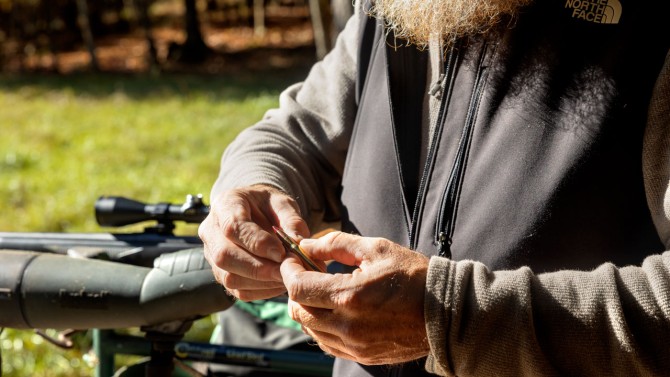
Brian Bird, a veteran hunter who chairs the New York chapter of Backcountry Hunters and Anglers, has switched to non-toxic copper rifle bullets for hunting white-tailed deer this season.
“I’m pleasantly surprised,” said Bird, who chairs the New York chapter of Backcountry Hunters and Anglers, which advocates for hunting, fishing and conservation on public lands.
This season, Bird will hunt with non-lead ammunition made entirely of copper. It’s a choice the New York State Department of Environmental Conservation (DEC) and Department of Health are encouraging the state’s more than 550,000 licensed big-game hunters to make for the benefit of both wildlife and human health, assisted by Cornell experts who have researched how lead ammunition impacts eagle populations and how best to communicate its risks.
Lead is a neurotoxin for which there is no safe level, especially for children and pregnant women, according to the Centers for Disease Control and Prevention. Despite successful efforts to remove it from gasoline, paint, household products and drinking water, lead persists in ammunition used by 95% of hunters pursuing white-tailed deer.
Lead rifle bullets shatter on impact into hundreds of fragments, killing an animal quickly and humanely. But the fragments – sometimes too small to see – can spread as far as 1 foot from the wound channel. That can potentially pepper game meat and carcasses with toxic particles, creating a hazard for humans and wild scavengers, including bald eagles. Consuming a lead fragment as small as a grain of rice can be lethal to an eagle.
Source: p. 2, Department of Environmental Conservation/State of New York
Lead rifle bullets shatter on impact into hundreds of fragments that can spread as far as 1 foot from the wound channel, potentially peppering game meat with toxic particles. Non-lead ammunition stays intact.
State agencies are stepping up education and outreach to promote voluntary adoption of non-lead alternatives, acting on recommendations from their Lead Ammunition Working Group, a multidisciplinary partnership that includes the Cornell Wildlife Health Lab. So far, the DEC has integrated the issue into an online hunter education course, shared a Cornell-produced educational video and introduced a pilot rebate program, whose effectiveness Cornell researchers will study.
Conservation-minded hunters like Bird and other advocates are now working to raise awareness and ease concerns, recommending lead-free ammunition as an equal and safer alternative.
“The problem and solution seem surprisingly simple at first,” said Dominic Balog-Way, research associate in the Department of Communication in the College of Agriculture and Life Sciences (CALS). “After all, why would anyone knowingly eat lead, or fire lead ammunition that may be consumed by vulnerable wildlife, when there are alternatives? Our in-depth research, however, shows the issue is much more complicated.”

A bald eagle is perched at the Montezuma National Wildlife Refuge in New York’s Finger Lakes region. A conservation success, nesting pairs in the state have increased 28-fold over nearly 30 years, but Cornell research has found that lead poisoning slowed their growth rate by about 5%.
At the edge
In mid-September, a resident reported a downed bald eagle – lethargic and unable to lift its head – behind a home in Elba, New York, north of Batavia in Genesee County. A DEC environmental conservation officer transported the bird to a wildlife rehabilitator near Rochester, who covered its head to reduce stress, cleaned it of black flies and administered fluids. The next day, the rehabilitator drove the eagle two hours to the Janet L. Swanson Wildlife Hospital in Ithaca, part of the College of Veterinary Medicine (CVM).
Despite aggressive care, the eagle died the following day. It would become one of nearly 900 bald eagles necropsied by the New York State Wildlife Health Program, a 13-year-old partnership between the Cornell Wildlife Health Lab, housed in CVM’s Animal Health Diagnostic Center, and the DEC’s Wildlife Health Unit.
Source: Diogo Guerra 2015
Lead from ammunition enters the food chain, exposing humans and animals to health risks
from the toxic lead particles.
After testing negative for bird flu, the deceased bald eagle’s thin frame, pale heart and distended gallbladder suggested lead poisoning to a Cornell pathologist. Toxicology tests of liver tissues soon confirmed a severe case – with lead levels more than seven times above a toxic concentration.
Such diagnoses are not uncommon.
In New York, as across the lower 48 states, bald eagles – iconic symbols of the nation, delisted as an endangered species in 2007 – are a conservation success story. Between 1990 and 2018, the number of breeding pairs increased 28-fold, from just 13 to 369, according to the DEC.
But Cornell researchers, partnering with state wildlife agencies including the DEC, have found that lead toxicity caused a drag on that growth, akin to driving with a foot on the brake, said Krysten Schuler, a wildlife disease ecologist who directs the Cornell Wildlife Health Lab.
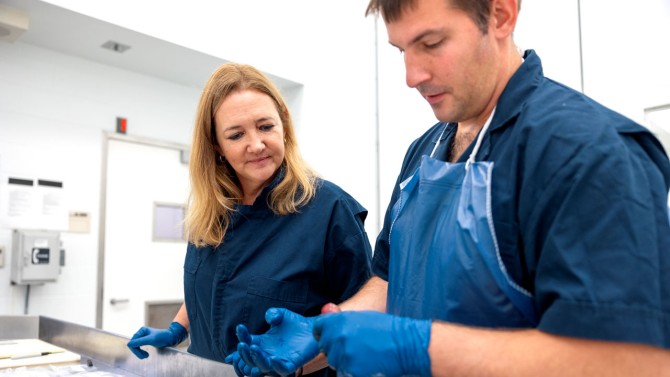
Krysten Schuler, director of the Cornell Wildlife Health Lab, looks on as pathologist Gavin Hitchener performs a necropsy on a bald eagle at the College of Veterinary Medicine’s Animal Health Diagnostic Lab. The bird died from lead poisoning, two days after being found behind a home in Elba, New York.
“Everybody can see there are way more eagles than there were a few decades ago,” Schuler said. “But their recovery wasn’t as efficient as it could have been.”
Among more than 1,200 bald eagles examined over nearly 30 years in seven northeastern states, including New York, researchers found that 78% were exposed to lead and 37% had toxic levels. Comparing actual eagle populations with what they could have been absent lead exposure or poisoning, they found lead had slowed the growth rate by about 5%. A New York-specific study reached a similar conclusion.
While 5% might not sound like a huge amount, Schuler and Kevin Hynes, a biologist who leads the DEC’s Wildlife Health Program, said the studies confirmed lead poisoning has a population-level impact. That diminishes eagles’ ability to manage additional challenges, including the deadly bird flu that emerged in 2021.
“They’re right at the edge of how many insults they can absorb,” Schuler said. “If other things come along, like introduced diseases or wind energy development, those might be enough to change the population’s trajectory."

A ballistic gel block shows how lead bullets shatter on impact, losing a significant portion of their mass. Lead fragments can pose a health risk to scavengers, and to people who eat game meat. Non-toxic copper bullets, in contrast, do not fragment, retaining their mass.
Proud conservationists
Bullet fragments are the only confirmed source of lead found in eagles, Hynes said, despite speculation by some about fishing tackle or old batteries. In his office outside Albany, Hynes keeps a collection of petri dishes storing fragments he’s recovered from eagle necropsies, ranging from small chunks to fine particles.
In most cases, the lead fragments originated in animal carcasses or gut piles – the entrails left behind after a hunter harvests game meat – which the scientists refer to as “attractive nuisances.” New York hunters in 2022 harvested more than 230,000 deer, according to DEC estimates, three-quarters of them taken with rifles or muzzleloaders that primarily fired lead ammunition.
“It’s like a magnet for these birds,” Hynes said of the remains. “They will not pass up the opportunity for a free meal.”
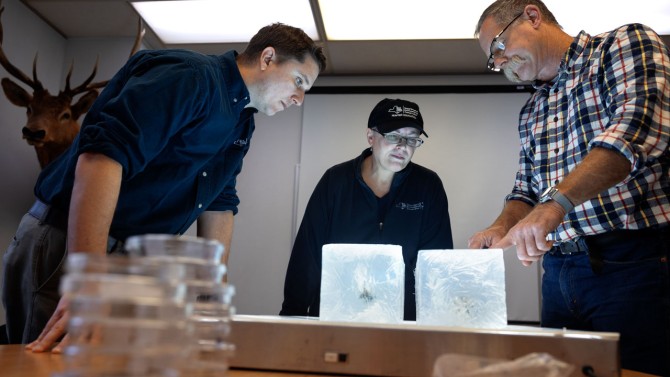
At the New York State Department of Environmental Conservation’s Wildlife Resources Center in Delmar, New York, from left to right, wildlife biologists Matthew Palumbo, Kelly Stang and Kevin Hynes compare ballistic gels displaying the difference between lead and copper bullets.
Eagles’ highly acidic stomachs quickly break down and distribute lead throughout their bloodstream, making them and other birds of prey more susceptible to poisoning than mammalian scavengers. The consequences have been documented most extensively in bald eagles, the Wildlife Health Program biologists said, because the public pays more attention to them and reports them more often than other less recognized species.
“Scientifically,” Hynes said, “it’s not a complex issue.”
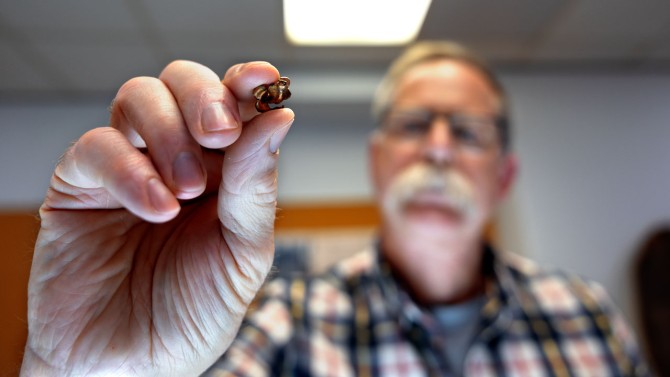
Kevin Hynes, head of the New York State Department of Environmental Conservation’s Wildlife Health Program, holds what remains of a copper-jacketed lead bullet recovered from a deer. The petaled copper jacket is intact, but the lead core fragmented inside the animal.
Unlike other causes of eagle deaths – including strikes by cars or trains, electrocution and attacks by other eagles – lead poisoning could be eliminated by a switch to non-lead ammunition. Solid copper bullets used for big-game hunting, which were developed in the mid-1980s, “petal” or “mushroom” on impact rather than fragmenting, retain most or all of their mass and are non-toxic if ingested. Hunters who choose to continue using lead ammunition could help protect eagles and other scavengers by burying or removing deer gut piles.
Hunters are proud conservationists – their license fees and excise taxes substantially fund U.S. conservation programs – and they don’t want to hurt anything but the target animal, Hynes and Schuler said.
“We want people to hunt, we encourage that,” said Schuler, herself a deer hunter whose family has transitioned to all-copper bullets. “This is about knowing what that lead bullet is doing after you fire it. We want to get the word out so hunters can make their own choices about what they can do to lessen this problem.”

Brian Bird of Whitehall, New York, grew up hunting with his father in the state’s Southern Tier and now chairs the New York chapter of Backcountry Hunters and Anglers, which advocates for hunting, fishing and conservation on public lands.
A choice of ammunition
One such effort has been “Your Choice of Ammunition,” a Cornell-produced, evidence-based video that the DEC has shared on its website and made available for nearly 2,000 volunteer instructors to use in classes required to earn a hunting license.
The video features hunters and instructors discussing the performance and health issues related to lead and non-lead bullets, and why they’ve chosen non-lead.
“It’s directed at New York hunters and features New York hunters,” said Kelly Stang, a wildlife biologist who leads the DEC’s Hunter Education Program. “We thought it was a good video that presented all the issues.”
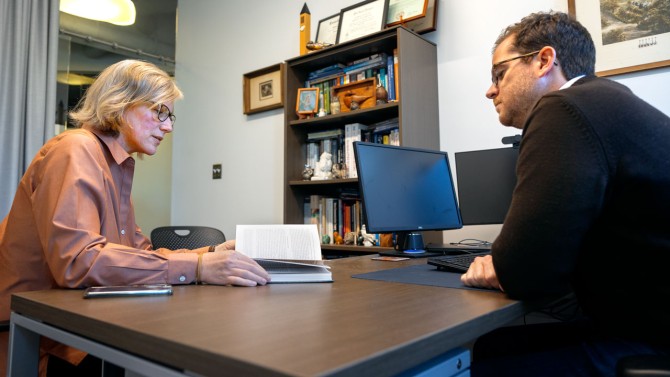
Katherine McComas, professor of communication in the College of Agriculture and Life Sciences (CALS) and vice provost for engagement and land-grant affairs, and Dominic Balog-Way, research associate in the Department of Communication (CALS), conducted research that informed “Your Choice of Ammunition,” an educational video shared on the New York State Department of Environmental Conservation’s website.
Informing the video, which received a positive response from most instructors, was research by a team led by Katherine McComas, Ph.D. ’00, professor of communication (CALS) and vice provost for engagement and land-grant affairs, and
including Balog-Way; Alisius Leong, a doctoral student in the field of communication; and David O. Brown, a photographer at the Johnson Museum of Art, supported by the Cornell Atkinson Center for Sustainability. Rather than simply promoting a scientific message – saying there are no safe levels of lead, for example – the team determined a better approach would present perspectives and options from hunters to hunters.
“We’re not going to tell them what the right thing to do is,” McComas said. “We want to provide the information in a way that they can engage with it, weigh the pros and cons and decide what’s right for them.”
To be effective, communication about lead ammunition’s risks must strive to understand and address hunters’ legitimate concerns, said Balog-Way, who conducted in-depth interviews with 20 volunteer hunter education instructors in New York. A follow-up survey of 560 instructors strongly supported the interview results.
Balog-Way found that some had switched to non-lead alternatives, while some were deeply skeptical of the issue, perceiving it as anti-hunting and an attack on their rights, traditions and freedom. Most did not know much about the issue and were ambivalent about switching, but open to learning more.
The researchers also learned that hunters had good reasons for resisting a rush to embrace non-lead alternatives. Amid a broader ammunition shortage, non-lead rifle bullets are difficult to find, because demand is low and because New York does not allow online sales of ammunition. (Brian Bird visited four stores before finding the right caliber, more than an hour from home.) And though comparable in price to premium lead options, their cost could potentially discourage lower-income New Yorkers from hunting – a barrier the DEC’s new rebate program seeks to address. Some hunters also are uncertain about non-lead bullets’ performance and compatibility with their weapons.
All the instructors opposed a ban on lead ammunition – so far only enacted in California, home of the endangered California condor – which they viewed as anti-hunting. In its 2022 report, the Lead Ammunition Working Group advised that legislative action was premature and could potentially provoke a backlash among hunters, suggesting the state focus instead on education and raising awareness.
Bird’s organization, Backcountry Hunters and Anglers, backed that approach, saying a transition away from lead ammunition was “best achieved through hunter education.”
Through the working group’s ongoing collaboration, the Cornell team continues to test messages with hunters, who generally express more concern about lead’s impact on wildlife and downplay the less visible threat to human health. Nonetheless, the working group, which also includes the Venison Donation Coalition, is investigating ways to minimize the potential for contaminated venison – especially when ground – that may be donated to food banks.
Continued progress, McComas and Balog-Way said, will require perseveranceand long-term commitment.
“If you understand where your common ground is on these goals, then you can work to have more of a conversation,” McComas said. “There are a lot of shared goals here in terms of wanting to preserve the hunting tradition for generations to come, wanting to preserve wildlife and wanting to preserve public health.”
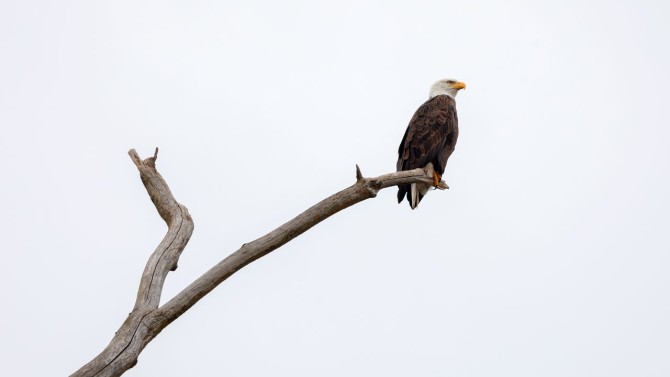
Eagles’ highly acidic stomachs quickly break down and distribute lead through their bloodstream, making them and other birds of prey more susceptible to lead poisoning. Consuming a lead fragment the size of a grain of rice could be lethal to an eagle.
Connecting to nature
Brian Bird hunts for food, and because the experience makes him feel intensely connected to nature, exposing him to scenes he said you’d never see in a wildlife documentary. He recalls receiving an owl’s penetrating gaze after it alighted on a nearby branch, apparently interested in hunting from the same spot.
Bird isn’t too worried about health risks from venison that he butchers himself.
But lead’s potential danger to wildlife hit him hard while turkey hunting in Michigan a few years ago, when he saw a familiar eagle quickly swoop down to a carcass discarded near his camp. He resolved then to bury carcasses and transition to non-lead ammunition.
“I’m not going to be responsible for potentially killing that eagle,” Bird said. “If I save one eagle, that’s worth it to me.”
This story and video were developed and produced by James Dean and Noël Heaney, with support from Matt Fondeur, Sreang Hok, Seung Yeon Kim, Eduardo Merchán and Marijke van Niekerk. It was edited by Lindsay France and Susan Kelley.
Media Contact
Get Cornell news delivered right to your inbox.
Subscribe


